You don’t realise how important your washing machine is until it stops working. Think about it, this humble unit keeps the household running from washing school uniforms to work shirts, saving you from doing it all by hand. Don’t waste time on a laundromat, read on for our guide on possible problems and solutions if you’re washer is under the weather.
Why is my washing machine not turning on?
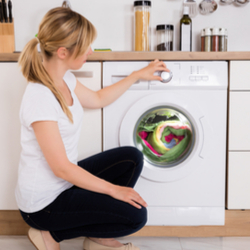
There are several factors as to why your washing machine isn’t turning on in the first place:
- It might not be plugged into the wall socket and in turn isn’t receiving any electrical power. You can check the wall socket itself by plugging another appliance in, such as a lamp, to ensure the power hasn’t blown out. Otherwise you may need to check your circuit breaker.
- You can also check the units power cord to see if there are any frayed areas or a break, which will require you to replace the cord.
- Some machines also have a safety system in place that requires the washer lid to be fully closed before it can turn on.
- Washing machines are also fitted with a lid switch which might be broken. To test it, open the lid and locate the switch, then press and release it. If it doesn’t click, it may require replacing.
Why did my washer stop working mid-cycle?
If your washer has stopped mid-cycle it could be because it has an overload protector system that locks the motor. Heavy wash loads can put strain on the motor. When this happens, the unit might display an error code to inform you of this issue. Typically, you’ll need to take some of the load out to allow the system to reset itself and restart the machine. In some instances, to reset the unit you might need to unplug the machine completely before re-plugging it.
How do you reset a washing machine?
How to reset a washing machine will depend on the brand and specific model you own. You may need to consult your manual or the brand’s website as the following steps may differ:
- Turn off the washer by pressing the ‘Power’ button
- Unplug the washer from the power outlet
- Turn off the circuit breaker to the unit
- While the power is disabled, press and hold the start/pause button for 5 seconds
- Replug the washer
- Turn on the circuit breaker
If the error continues to show up, you may need a repair service.
Why is my washer leaving residue on my clothes?
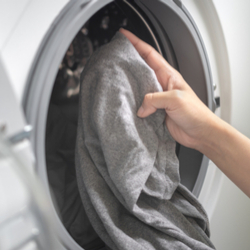
If your washer isn’t rinsing properly, you might find detergent residue on your clothes after a cycle. it might be from a number of reasons:
- Detergent: it’s important to evaluate how you’re using the washing machine. Are you putting the right amount of detergent in? Are you using enough water for the load? The detergent itself might be leaving residue if there’s too much of it or if there’s not enough water to dissolve it.
- Dirty drum: overtime the drum might collect greasy residue that requires cleaning. You can use the tub clean cycle for this (if available) otherwise wipe the tub by hand.
- Overloading: if you’re overloading the unit, it might struggle to wash your garments thoroughly and in turn, leave residue. Your manual should specify how much weight you can safely put into your washing machine (online copies are usually available via the brands website). This is what 1 kg of washing looks like:
Why doesn’t my washer spin out all the water?
If your washing machine won’t spin out all the water after a cycle, or isn’t draining out correctly, follow the following steps:
- Inspect the supply hose: to do so, switch off the unit and turn off the water supply. Disconnect the hose from the unit and put the end into a sink or bucket and turn the tap back on. Ensure there is a strong flow otherwise this might indicate it’s partially blocked. Make sure it’s open all the way and hasn’t kinked anywhere. Clear out any blockages or replace the hose if necessary.
- Inspect the drain hose: check the drain hose as well to ensure it’s draining out all the water. If there’s a blockage it can cause the water to back up and stay in the drum. Clear out any blockages if necessary.
Why is my washing machine leaking?
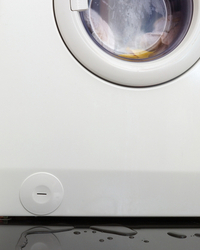
A washing machine leak might be caused by a hose or loose connection:
- Turn off the water
- Remove the hoses and drain them into a bucket
- Check the fittings: check the fittings where the hoses connect to the unit as well as the fittings that connect to the tap. Tighten hose fittings if necessary or replace them
- Check the seals: check the door seal and clear out any soap residue that may have build-up. Replace the seal if necessary
- Check for blockages or worn out hoses: make sure the water leak isn’t cause by a backed-up hose. Worn out hoses might need to be replaced
- Check for suds: the overflow of suds might occur because of too much detergent or if you’re using wrong type of detergent. There are various homemade remedies you can find online to clear this including putting two tablespoons of bicarbonate soda into the detergent drawer and half a cup of white vinegar into the drum, then running a normal wash
Why is my washing machine shaking?
If you find your washer shaking abnormally, it might be from different reasons including:
- The wash load is out-of-balance: check if some clothes have bundled together on one side of the tub and adjust the load if necessary.
- The machine isn’t levelled: check the machine for levelled support. Ensure the floor that the machine is standing on is flat and is strong enough to support a fully loaded washing machine.
Follow the specific steps below to help level your washing machine.
How to level your washer
- Ensure the washing machine is turned off and unplugged
- Check levels of the feet: look underneath the washing machine and ensure all feet are resting on the floor properly. Tighten the feet if necessary. Place a level on top of the machine to check and adjust the feet if needed
- Check the rubber caps: the front legs of a washing machine generally have rubber caps. Make sure they are fitted on tightly and replace them if needed
- Check back feet: this can be done by tilting the washing machine forward if necessary
- Replug the unit and turn it back on
- Run a cycle to check for vibration
Why is my washing machine making noises?
If your washer is making a loud noise during a spin cycle, it could be caused by:
- Faulty belt
- Clutch assembly has worn out
- Failing drive motor
Typically, the above instances require a manufacturer’s assistance. It might also be an item that you’ve forgotten to take out of your pockets such as loose change, which will require you to stop the cycle and remove.
Why isn’t my washing machine spinning?
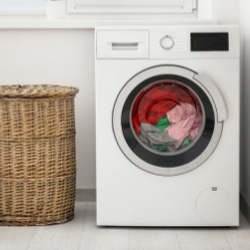
There are several reasons why the machine might not spin or agitate. It could be from:
- Faulty lid switch: if the switch is broken, the unit might halt during a cycle. Replace the switch if needed.
- Broken belt: tighten the belt if it has become loose otherwise it might be broken and needs to be replaced.
- Defective buttons: it’s possible that the controls are not working, which might require a repair.
- Load jammed: if any garments have jammed, making the drum unbalanced, you may need to readjust the load.
Other situations such as a faulty motor, may require a repair service.
Regular maintenance
Before spending money on a service, it’s important to consider how long you’ve had the washer for. In Canstar Blue’s customer surveys, we’ve asked thousands of Australian households about how long they owned their appliances before replacing them. Based on these findings, the average life expectancy of front loaders was found to be 8 years and for top loaders it is 9 years. To help prolong the life of your washing machine, ensure that you conduct regular maintenance, as well as use the correct amount of detergent, and don’t overload it.
Tub clean cycle
It’s recommended to run a tub clean cycle (if available) about once a month or every 30 washes. You might need to run it more often if there’s a smell coming from the tub.
- Empty the drum
- Add washing machine cleaner (tablets are recommended to be placed directly in the drum while powder or liquid can be placed in the dispenser)
- Start the tub clean cycle
- Wait for the washer to cool down
- Wipe the washer lid and glass door with a towel or soft cloth
- Leave the washer lid open to ventilate
The tub clean cycle might help your washer maintain its optimal performance and it does the job for you with one press of a button.
Clean filters
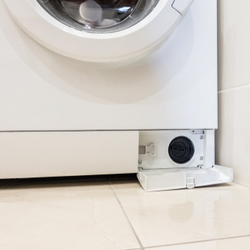
Washing machines are generally fitted with a water inlet filter, which can get clogged especially if you live in an area with hard water. Newer models are designed to detect if the water is not entering the dispenser properly and show an error sign. To clean the filter:
- Turn the water taps off
- Turn off the washing machine and unplug it
- Unscrew the hot and cold water lines from the back of the washing machine
- Drain out the hoses into a bucket
- Remove the inlet filter by using pliers or any other tool with small tips
- Soak the filter in lime scale remover or white vinegar
- Wash filters thoroughly in warm water to remove all build-up
- Rinse filters before reinstalling and re-attaching the water lines
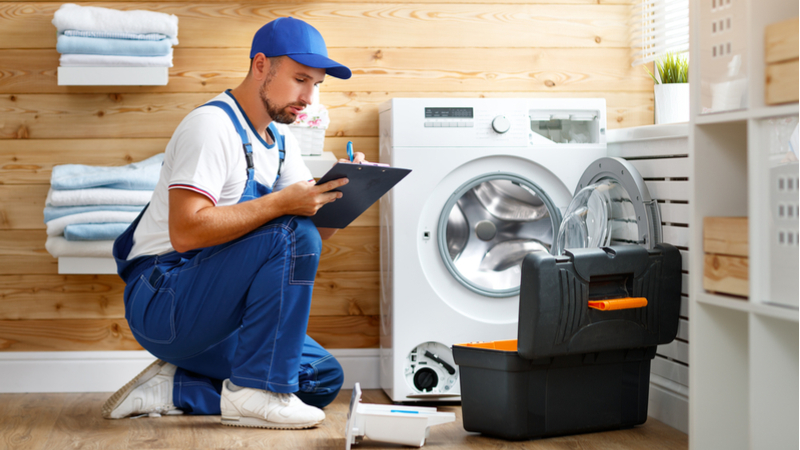
The wash-up
As not every problem can be fixed, you may need to call a washing machine repairer. However, if your washer is drawing to the end of its life, consider purchasing a new one with a high energy-efficiency rating. Washers are constantly being upgraded, so there might be a lot of additional functionality that might be of benefit to you. Units with Wi-Fi connectivity from brands such as Samsung and LG allow you to troubleshoot problems via an app. To see which brands are keeping Aussies happy, follow the link below to our online ratings.
Picture credits: New Africa/shutterstock.com, Andrey_Popov/shutterstock.com, tete_escape/shutterstock.com, Bacho/shutterstock.com, Africa Studio/shutterstock.com, Elena Loginova/shutterstock.com, Evgeny Atamanenko/shutterstock.com
Original Author: Veronika Hleborodova


Share this article